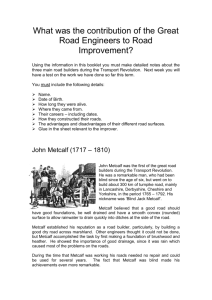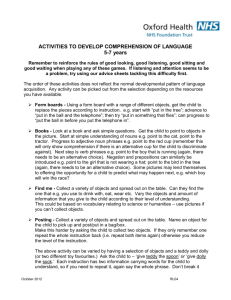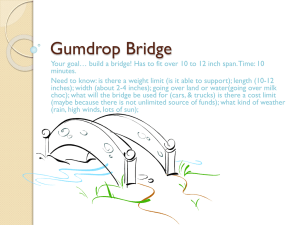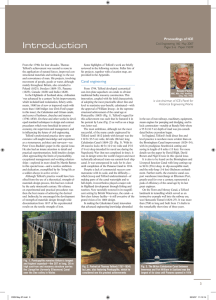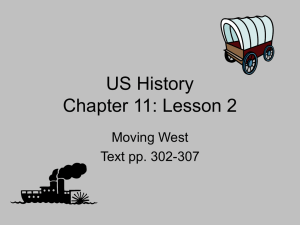Thomas Telford
advertisement
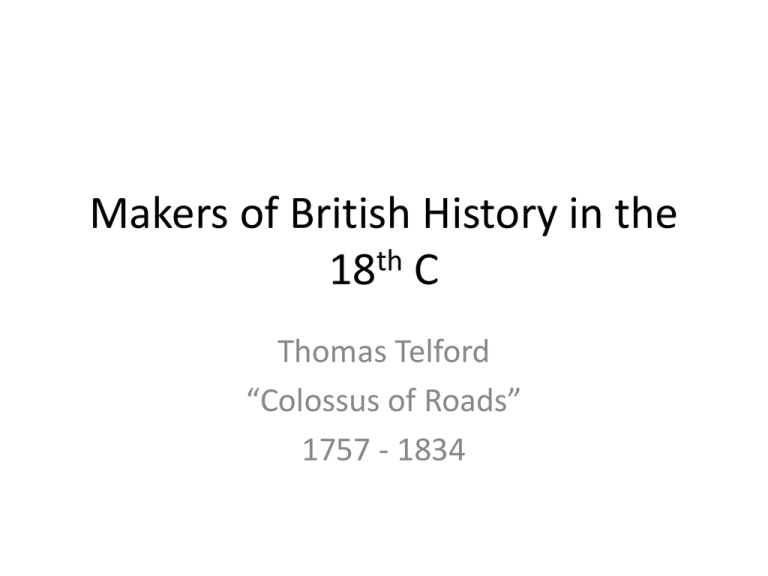
Makers of British History in the 18th C Thomas Telford “Colossus of Roads” 1757 - 1834 This is a short PowerPoint presentation by Victor T.C. Middleton, on the remarkable life and significance of Thomas Telford – Civil Engineer. Telford’s contributions are set In the context of the transport/industrial/and technological revolutions of the 18th Century. The slides were used as a basis for a talk given to U3A on October 21st 2014 In the Coronation Hall, Ulverston. The sources on Telford are vast because of the significance of the man in his time and his legacy, which lives on. Those who seek further information may find it helpful to start with: S. Smiles; 1861; The Life of Thomas Telford: Civil Engineer; Updated 2011 L.T.C. Rolt; 1958; Thomas Telford; Peter Smith; 1972; Waterways Heritage; for Museum & Art Gallery, Luton Telford around 1797 Context of transport in England pre 1700 Turnpike Roads in the 18th century Transport pre 1700 • Rich rode and poor walked - goods by cart or pack horse………… • Roman Roads linking key Forts and early canals – but largely left to decay for centuries • 16th C focus on rivers and navigation improvements • 1663 First Turnpike Act; Commercial Turnpike Trusts established in 1706 - Toll roads (but 50 years on for major impact – road engineering by blind John Metcalfe) The industrial revolution was full on energy, enterprise and hard graft – but not pretty Industrial Revolution • • • • • • 1709 - Abraham Darby (1) - Iron works at 1761 - Bridgewater Canal 1764 - Arkwright’s Spinning Jenny 1774 - James Watt - rotary steam engine 1771 - World’s first factory established 1770s - London Stock Exchange created Industrial Revolution impossible without affordable means of moving goods for trade, raw materials and finished goods - and for making urbanisation and factory production possible for domestic and international markets • • • • • Coal Iron Textiles Agricultural supplies Manufactured goods Also impossible without pioneering designer/engineers whose vision, skill, energy, determination and enterprise would drive projects through to conclusion. “The men who built our bridges, docks, lighthouses, canals and railways were mostly country bred boys who were originally hands-on craftsmen and self taught in the science, technology and arts of their projects. They laid the foundations of what became the civil engineering profession” (Rennie was the exception) Brindley, Smeaton, Jessop, Metcalf and Telford Canals and Rivers in England and Wales “ The opening up of the internal communications of a country is undoubtedly the first and most important element of its growth in commerce and civilisation.” Richard Cobden (1804 – 1865) Telford’s Early Days • • • • • • • • Son of a shepherd in Eskdale, Dumfries – Langholm Orphaned in year he was born Learned the basic 3 R’s at a Parish School Apprenticed at 14 to a stone mason where he first learned the intricacies of masonry and craftsmanship Including work on his first bridge Known as ‘Laughing Tam’ for his good humour. Found Early supporter/patron in a Miss Pasley Edinburgh New Town Achievements and some Key Dates 1780 - (aged 23 employed as mason in Edinburgh 1782 - to London and work on Somerset House 1784 - Superintendent of Port Admiral’s House in Portsmouth (designed by Samuel Wyatt) 1786 - (aged 29) Surveyor of Public Works for the County of Salop. Designing and constructing bridges, roads, public buildings – project management 1793- (aged 35) Invited to be sole agent, architect and engineer for the Ellesmere Canal Telford the remarkable man • Humble origins, little formal education • Totally dedicated; honest and upright; trusted and respected • Methodical, nothing to chance, an excellent judge of character • ‘Laughing Tam’ • A scholar by instinct and practice - and a poet Pontcysyllte Aqueduct over the River Dee PontyCysyllte Aqueduct 1795-1803 • 1500 ft embankment into valley of the Dee • Masonry piers supporting 19 arches across the river and valley - over 1000 ft long • Cast iron trough for the canal 127 ft above the river Chirk Aqueduct 1801 with rail way bridge behind Some Key Achievements – still standing and operational 1803 – Pont-Cysylltau and Chirk aqueducts 1803 – Roads and bridges in Lowlands and Highlands of Scotland (1200 bridges over next two decades) 1804 – 1822 Caledonian Canal (Rennie and Watt) 1810 - Gotha Canal in Sweden (55 miles) 1814 – Dundee Harbour Craigellachie Bridge - Highlands. Suspension Bridge over the Menai Straight Menai Straights Suspension Bridge - 1825 • Largest structure of its type ever attempted – to Link Holyhead, Birmingham and London • Months of methodical experimentation using latest iron techniques – all supervised by Telford (only reference to sleepless nights) • 7 masonry arches; two massive piers 153 ft high; 16 chains to suspend the roadway • One chain was 570 ft long weighing 23.5 tons Suspension Bridge at Conway Castle Canals and Rivers in England and Wales More lasting achievements 1816 - Design of Carlisle to Glasgow Road 1818 - Grand Trunk Canal Sections 1822 - (1804) Caledonian Canal (Rennie and Watt) 1824 - Harecastle Tunnel (16’ high and 14’ broad) 3,926 ft long 1826 - Birmingham and Liverpool Junction 1827 - St Katherines Dock London 1834 - Design to improve docks at Dover St Katherine’s Dock, London Dover Harbour – a modern view Telford’s Philosophy “We do not consider anything to be impossible. Impossibilities exist chiefly in the prejudices of mankind , to which some are slaves and from which few are able to emancipate themselves and enter on the path of truth.” (Bridge over the Danube) He admired commercial enterprise and its activity, energy and intelligence. “But I hold that the aim and end of all ought not to be a bag of money, but something far higher and far better.” A tribute from Robert Southey Poet Laureate and close friend “ Telford’s is a happy life; everywhere making roads, building bridges, forming canals and creating harbours – works of sure, solid, permanent utility; everywhere employing a great number of persons, selecting the most meritorious, and putting them forward in the world in his own way.” Telford’s Influential Legacy lives on • Designed and built to last! • Pivotal role in a national transport system • Pioneered and developed the engineering design and project management techniques • International figure • First President; Institution of Civil Engineers • Influence on Victorian Red Brick universities?

